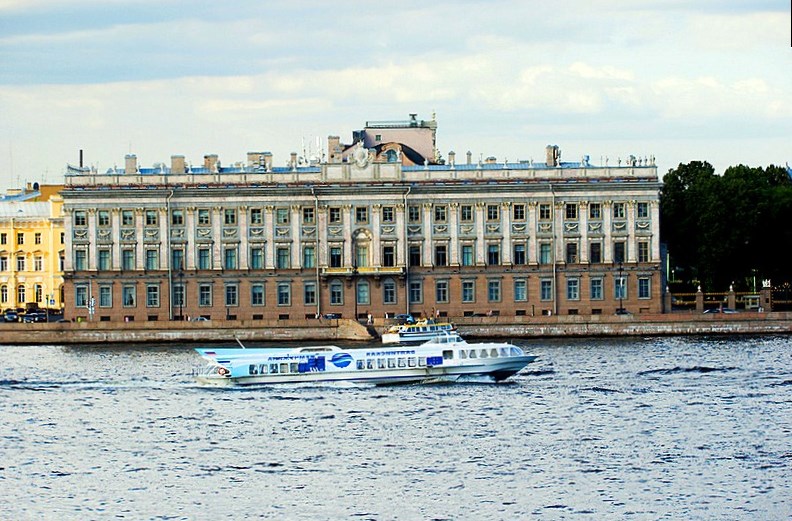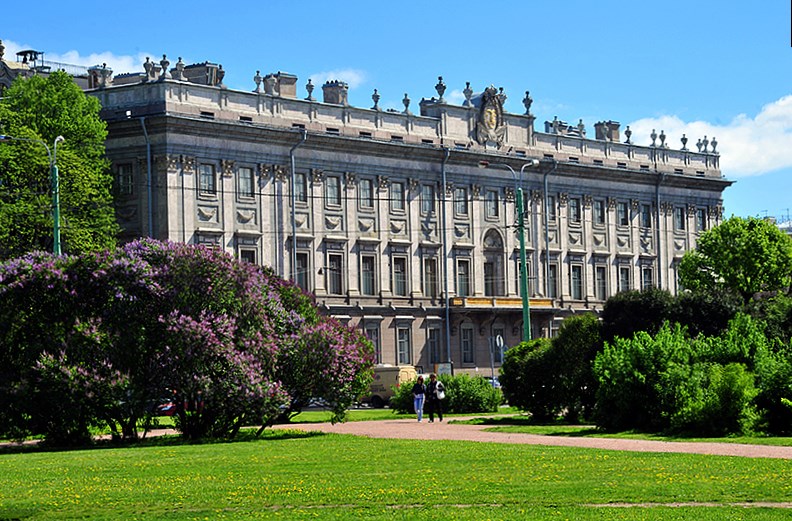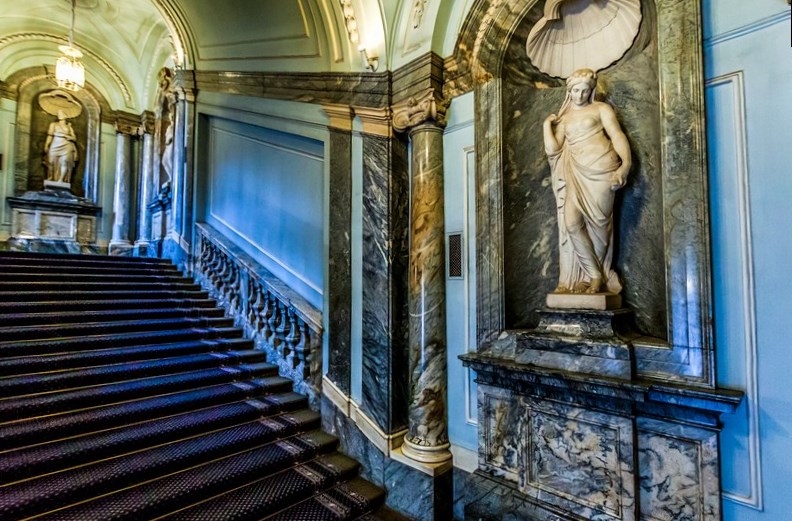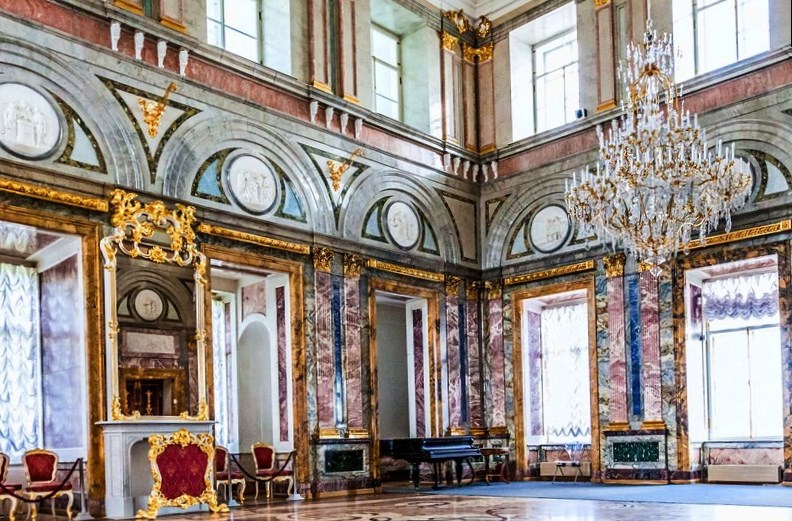The Marble Palace in St. Petersburg became the first St. Petersburg’s building covered with natural stone.Marble was used not only for coating of facades but also for decoration of the inner halls in the building. Therefore it received the name - the Marble Palace.
History of the Marble Palace in St. Petersburg
On the territory where the Marble Palace is situated now was formerly a Pitey House which in 1714 was rebuilt to the Post House with a marina.At first the Post House was a Mazankov building and till 1716 it was wooden and two-storey. On the second floor Peter I held festive events and assemblies. There was also a hotel whose guests were dispossessed at the arrival of the king. The postal quay is now called Dvortsovaya. On the place of Post House was built the Manege which later has been burned down.

On free territory under the project of architect Antonio Rinaldi a palace was built which Catherine II gifted to her favorite Earl Orlov for assistance in the events of 1762, thanks to which she took the throne. The Earl thanked her gifting a huge diamond in 189.62 carats.
The building has been built from October 10 in 1769 to 1785. Shortly before finishing building of the construction, the Earl died and Catherine bought the house in his heirs and before her death she gifted it to the grandson - Grand Prince Konstantin Pavlovich.
Later, the house on the quay belonged to two Konstantines else - the second son of Nicholas I - Konstantin Nikolayevich and his grandson Konstantin Konstantinovich, the president of the Russian Academy of Sciences and the famous poet of the Silver Age who wrote under the pen name "K.P."
The Marble Palace was even called Konstantinovsky despite the fact a palace with such name has already been in Strelna.
In the middle of the XIX century a renovation of the building has been carried out under the project of Alexander Bryullov. The original outlook of interiors was lost in the result of further reorganization for the needs of the museum.
In 1992 the building was transmitted to the Russian Museum. Since that time the interior and prior layout of rooms had been restored.

Exterior arrangement of the Marble Palace in St. Petersburg
The marble box with coins was walled-in in the basement of the building construction. Catherine II personally monitored the progress of the work and encouraged especially distinguished ones.About 100 bricklayers and up to 300 artillery fusillers worked on the building of the construction. Huge blocks of marble were delivered on the Neva.32 sorts of marble were used for the decoration of the facades and inner interiors.For the revetment was brought a material, mined in quarries near Ladoga and Onega lakes. And white marble was delivered from Italy.It was cheaper than carrying it from Altai or the Ural. Upon completion of the construction, an inscription "Building of Thanksgiving" was installed above the entrance. A turret with clocks was installed higher.And on the sides of the tower - two figures: to the right - Fidelity, to the left - Generosity, the works of the sculptor F.I.Shubin. The inner interiors adorn almost 40 of his works.In 1780-1788 in the eastern part of the sector the office building was built.The caretakers and stables, playpen and hay warehouses have been located in the office building. The apartments of servant were on the second floor.The red channel connecting Neva and Moika was swamped. Between buildings a lattice was installed (work by P.E. Egorov), that was similar to the fence of the Summer Garden.
In the created project Rinaldi succeeded in realizing two functions: a city house and a noble country barton. The lines of the southern, western and northern facades were organically suited to the city building and from the side of the yard we see a noble barton with a festive yard, a garden and a fence.
The western part of the palace, destined for economic needs, had the same plan as the front door but it was closed by obverse facades of corps, located on Million Street, the Palace quay and Marble Lane.

Inner decoration of the Marble Palace in St. Petersburg
According to Rinaldi's intent, the peculiarity of architectural decoration of the Parade staircase had to become her artistic garnish - as a elongation of the stone garnish, begun on the facades of the building. Continence in the designing of the main palace staircase is explained by the desire of Catherine II to give the parade chambers a courageous and rigorous view specifying on the fact that its master belong to the strong half of mankind. The main staircase is prettified with statues of Morning, Day, Evening and Night symbolizing childhood, youth, maturity, old age. On the area from the second floor to the third there are sculptures representing the autumn and spring equinox. All the symbols of the main staircase glorified the military valor, hardness of spirit and achievements of Grigoriy Orlov.
On the ground floor there were kitchens, boiler rooms and a church consecrated in the name of Introduction to the Temple of the Blessed Virgin. There were various mechanisms in the service rooms. Thus in the building on the Million streetwas a machine for water supply, a well with pumps for supplying water to the main baths of the second floor. In the building on the Marble Lane there was a well with a pump for feeding water to Sadik. The pool for cleaning the mechanisms was located in the Nevsky Corps.
The main building of the house is the Marble Hall in which there are low reliefs as "Sacrifice", prepared for St. Isaac's Cathedral A. Rinaldi. Near the Orlovsky and Catherine halls were located which glorified the activity of the brothers Orlov and Catherine II as well as the chambers of Grigory Orlov. The picture gallery which was located in the south-eastern part of the house represented 206 masterpieces of painting (works by Rembrandt and Titian, Raphael and other masters). In the south-western part there were Greek and Turkish baths. The living rooms were located on the third floor; the ballroom was in the building on the Marble Lane.

Expositions of the Marble Palace in St. Petersburg
Exhibits in the palace represent the role of Russian art in the world. Here there is broached exhibition "Foreign artists in Russia of the XVIII-XIX centuries" which tells about the relationship between artists of Russia and Europe.
Famous German collectors, the spouses Peter and Irena Ludwig in 1995 gifted the collection of works of modern artists from Europe, America and Russia to the Russian Museum. Thus the "Museum of Ludwig in the Russian Museum" was appeared. This exposition gives an opportunity to see the development of Russian art in conjunction with the world of art culture.
The exposition "The collection of St. Petersburg collectors of the Rzhevsky brothers" is represented by exhibits gifted to the Russian Museum by the brothers Joseph and Yakov Rzhevsky.
In the chambers of one of the last owners of the Marble Palace, Grand Duke Konstantin Konstantinovich Romanov there is broached exhibition "Constantine Romanov - the poet of the Silver Age".
